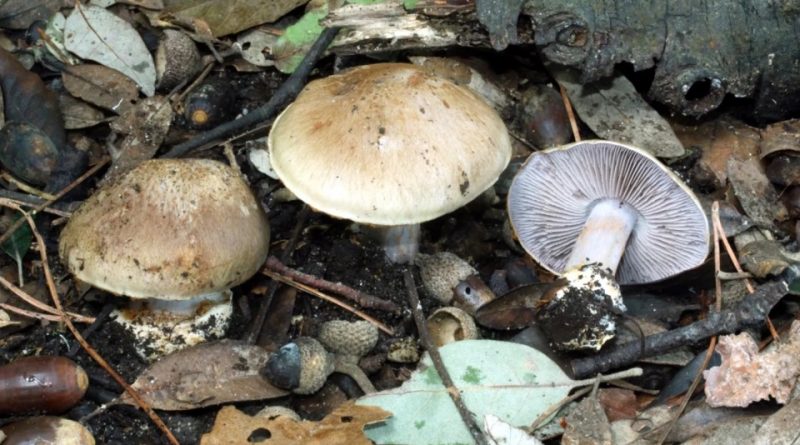Cortinarius olivaceofuscus
Cortinarius olivaceofuscus
The Cortinarius olivaceofuscus (Cortinarius olivaceofuscus Kühner, 1955) is a mushroom belonging to the Cortinariaceae family.
Systematic –
From a systematic point of view it belongs to:
Eukaryota domain,
Fungi Kingdom,
Phylum Basidiomycota,
Class Basidiomycetes,
Order Agaricales,
Cortinariaceae family,
Genus Cortinarius,
Subgenus Dermocybe,
Cinnamomei section,
Species C. olivaceofuscus.
The terms are synonymous:
– Cortinarius carpineti M.M. Moser ex G. Garnier 1991;
– Cortinarius schaefferi Bres. 1930;
– Dermocybe olivaceofusca (Kühner) Quadr. 1985;
– Dermocybe schaefferi (Bres.) M.M. Moser 1986.
Etymology –
The term Cortinarius comes from cortina: with a curtain, due to the characteristic residues of the partial veil from the brim of the hat to the jamb.
The specific epithet olivaceofuscus comes from the Latin terms “olivaceus”, i.e. olivaceous and “fuscus, a, um”, i.e. dark, dark, but also used with the meaning of dark brown, brown.
Geographic Distribution and Habitat –
Cortinarius olivaceofuscus is a mushroom that grows in a predominantly Mediterranean environment.
Its habitat is that of wooded areas in the presence of Quercus ilex (but found on other occasions under other oaks) with the presence of Carpinus orientalis or Ostrya carpinifolia but also in mixed forests of pines and holm oaks and on calcareous substrates.
Recognition –
The Cortinarius olivaceofuscus is a mushroom that can be recognized by having a cap of 20-40 (50) mm in diameter, bell-shaped and then more relaxed, with a slight central umbo, fragile, fibrillose cuticle, with small appreciated scales of an olivaceous color tending towards reddish and finally to brown, or more citrine yellow, olive yellow background color, with a darker, brownish disk.
The hymenium presents itself with dense, slightly wavy and sometimes even slightly crenulated, attached-unmarginated lamellae of an olive-yellow colour.
The stem is sometimes short but can be longer than the diameter of the cap, i.e. 35-40-60 mm x 5 mm, sometimes it is a little twisted, cylindrical, slightly widened at the base, sulfur yellow at the top, olive yellow at the base, which bears signs of an initially yellow-olive veil, then darkening; evanescent curtain.
The flesh is almost non-existent on the periphery of the cap, fibrous and then fistulous-hollow in the central axis, yellow-olive green, smell reminiscent of the opening of a pack of tobacco, or fruity with a light earthy component, slightly bitter taste.
The medium-small size, the olive colors of the entire carpophore and the habitat help in its recognition.
Under the microscope, spores with an almost quadrangular profile, subamygdaliform or ovoid, medium-small 6.5-8.4 x 4.3-5.5 µm, finely dotted, can be identified.
Tetrasporic basidia, cystidia with cylindraceous to clavate marginal cells, buckle joints present.
As regards the chemical reactions, they are the following: at the bases (including ammonia) ink red, then brick red, finally dark blood red, both on the flesh, on the cuticle and on the gills, dark olive at the base of the stem. In alcohol immediately forms an olive-green solution.
Cultivation –
Cortinarius olivaceofuscus is an uncultivated mushroom.
Customs and Traditions –
Cortinarius olivaceofuscus is a mushroom of unknown edibility, but should be considered suspicious. In fact, it is a species suspected of insufficiently known toxicity, to be subjected to new investigations and evaluations.
The thermophilic habitat under Fagales in Europe, and the bi-hemispheric presence with a very limited number of species described so far, lead to the hypothesis that it is a relict group from very ancient times, perhaps preceding the other Cortinarius (From the descriptions it would seem very close to the dermocibes of the subgenus Icterinula, section Icterinula, present only in the southern hemisphere).
This mushroom can be mistaken for Cortinarius croceus which, however, only grows under coniferous trees. Note a certain variability of the species which can have dark olive or citrine yellow shades, spores 6.5-8 x 4-5 or smaller (5.4-6.7 x 4-4.8) and larger. The DNA examination found that these are at least two species not yet separated so that this can be defined as a complex.
This species, until 2014, was considered a simple form of C. dionysae.
Preparation Method –
Cortinarius olivaceofuscus is a mushroom of unknown edibility, however since its edibility has not been ascertained, it is absolutely inadvisable to eat cortinari of small size and with showy colours.
Guido Bissanti
Sources
– Wikipedia, the free encyclopedia.
– GBIF, the Global Biodiversity Information Facility.
– Cetto B., 2008. Mushrooms from life, Saturnia, Trento.
– Pignatti S., 1982. Flora d’Italia, Edagricole, Bologna.
– Conti F., Abbate G., Alessandrini A., Blasi C. (ed.), 2005. An annotated checklist of the Italian vascular flora, Palombi Editore.
Photo source:
– http://www.ambpesaro.it/portfolio-item/cortinarius-olivaceodionysae/
– https://observation.org/photos/41892479/
Attention: Pharmaceutical applications and food uses are indicated for informational purposes only, they do not represent in any way a medical prescription; we therefore decline any responsibility for their use for healing, aesthetic or food purposes.


